Disclosure: Meeple Mountain received a free copy of this product in exchange for an honest, unbiased review. This review is not intended to be an endorsement.
Cats. Catty cat cattingtons. Bird-botherers, fish-filchers, dirtbox-dwellers and ‘The Smell’.
Believe it or not I actually like cats.
And with a game as gorgeous as this it’s hard not to. The Isle of Cats is lovely from the box lid down, filling you with the warm satisfaction of a cat purring on your lap.
Which is just as well, because the plot is barmy as a sack of kittens. No amount of beautiful artwork can convince you that you’re rescuing cats from imminent destruction by Lord Vesh Darkhand*.
Perhaps it’s a good thing. I mean, if you genuinely felt you were enacting a feline Dunkirk then you’d have to wonder what happens to those left behind… Don’t beat yourself up, they probably had it coming – this used to be the Isle of Birds.
*Yes, that’s his name. Yes, it’s a bit stupid. No, it has no impact on the game so let’s move on.
The Isle of Cats
The Isle of Cats is the latest game from UK designer Frank West and publisher The City of Games, sharing the same universe as The City of Kings, Vadoran Gardens and the upcoming Rising Blades. But other than the shared narrative setting there’s no connection between them.
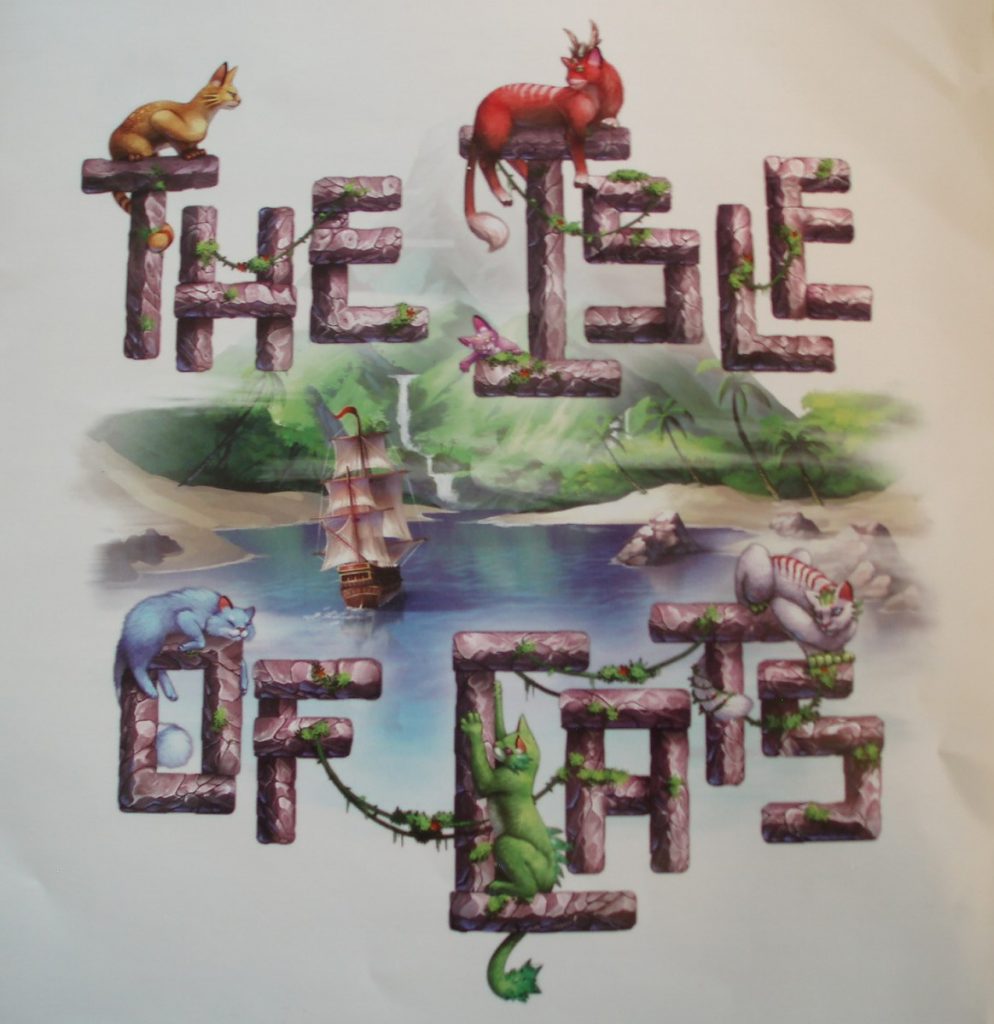
Brief Overview
Over the course of five rounds (days) one to four players draft cards to collect polyomino tiles (cats) that they arrange strategically on their player boards (boats) for points (points). Most points at the end wins.
Ever So Slightly More Detailed But Still Fairly Brief Overview
Let’s start with the beating heart of The Isle of Cats: the tile placement. To claim a cat tile you’ll need one basket (to catch the cat in) and some fish (for a lure), with the number of fish depending on which of the game’s central areas (known as fields) the tile is in.
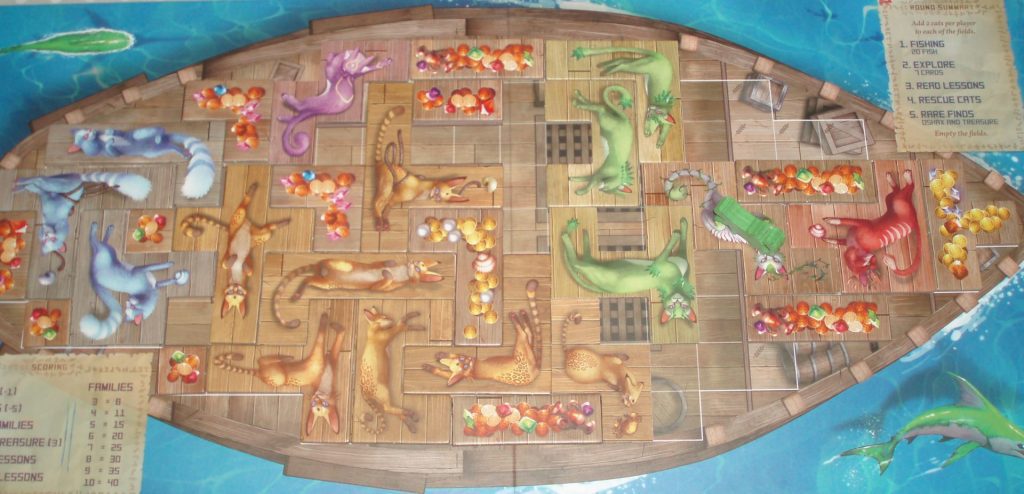
Strategically placing tiles on your boat gives you points (or negates negative points) for: grouping cat tiles of the same family (colour) together, placing tiles over rat spaces, completely filling any of the seven rooms on your boat, collecting rare treasures, and achieving lesson card goals.
Ah yes, the cards…
It turns out that The Isle of Cats is a bit of a Time Lord: two beating hearts and some interesting stuff around them.
At the start of each round everyone is dealt seven cards, each player then reserves two and passes five to their neighbour. Drafting continues – reserve, pass, reserve, pass – until everyone has reserved seven cards. But which of those cards do you want enough to pay fish for and which will you discard?
To answer that question you need to know what the cards do:
- Basket cards let you take cat tiles.
- Boot cards affect turn order, giving you first pick of the cat tiles.
- Treasure cards let you claim treasures – small, regular-shaped tiles that fit inconvenient spaces.
- Oshax cards give you large ‘joker’ cat tiles you can assign any colour to, helping family groupings.
- One-time cards give you special abilities like moving cat tiles between fields to change their fish cost or pulling more cat tiles out of the cat tile bag for additional choice between cat tiles. (It may be safest for all if I just refer to ‘cat tiles’ as ‘cats’.)
- Lesson cards give you points for filling your boat in a certain way. Perhaps you’ll need exactly five red cats or to have placed cats all around the edge of the boat. Some lessons benefit everyone around the table, others just you.

And there we have it: draft cards, pay for cards, buy cat tiles, place cat tiles, repeat another four times and then use the handily provided pencil and scoresheet to total up the scores. There are also family and solo modes which will be discussed below.
Thoughts
Let’s be clear from the start: The Isle of Cats is a great game, a delicious fusion of intertwining decisions.
Drafting Cards – The Exciting Decision
With 150 cards included it’s genuinely exciting to see what you’ve been handed. In some games, card drafting mechanisms can produce less interesting choices once the best cards are snagged. The Isle of Cats sidesteps this problem by restricting player choice: in reserving two cards each time there are only 3 decision points during each drafting phase. This curtails any saggy decline and keeps the game pacey.
Not needing to pay for all your reserved cards takes a little of the edge off the draft, but it incentivises knowing what the other players are up to. It’s easy to deliberately take cards that your opponents want because you can simply discard them and often the only person that knows you’ve been an arse is you. It’s fun!
Buying Cards – The Interesting Decision
One of the most generous moments in The Isle of Cats is at the start of each round when everyone gets twenty fish. Just like that you’ve won the piscine lottery. It feels nice.
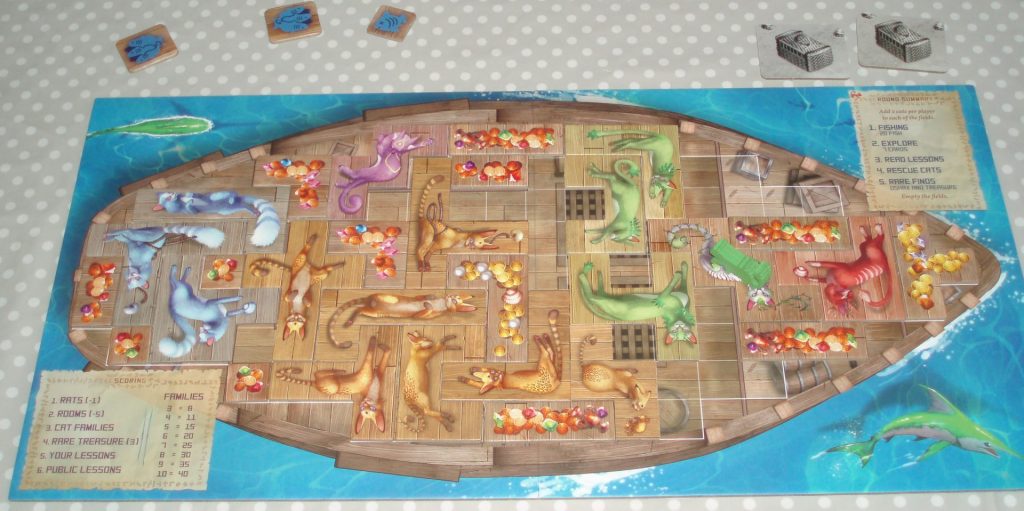
Twenty fish equates to four cats from the most expensive field or potentially all seven of your reserved cards (which cost between zero and six fish each). More likely it’s a mix of the two. Every card is useful, although some are more expensive for what they do than others. This feels like a deliberate design decision, forcing you to weigh up what seems reasonable at that moment in time. Working out which cards are worth keeping and balancing that against your future cat-buying potential is possibly the most interesting part of the game.
Buying Cat Tiles – The Perfectly Pleasant Decision
You’ll need one basket for each cat tile you want to purchase. Baskets are limited and you may only be selecting two cats in a round, certainly in the early game. Yet with lots of cats to choose from (four per player) it rarely feels tight, even if other players take the specific tile you were eyeing up.
It’s curious that in a game that’s so overtly about collecting cats, choosing which tile to buy is, in isolation, the least interesting part of the game. Of course, which tile you buy bleeds into where you intend to place it…
Placing Cat Tiles – The Satisfying Decision
Every cat you place slots pleasingly amongst the rest of your feline menagerie. The need to cover up rats and rooms competes with wanting to group like-coloured cats together and all of these impulses rub against the desire to plan for the long-term, leaving appropriate spaces for future tiles. The five treasure maps dotted across your boat add another dimension – place the same coloured cat over one of these and you get a free treasure tile. And, of course, there are those lesson goals you’re trying to achieve by placing tiles in a certain way.

All these factors mean that there’s never a right decision – any one cat tile can be slotted into a multitude of places and still reward or cost you. When it goes right, boy does it feel satisfying:
I buy a red cat tile and place it next to two red cats to create an 8 point earning family, at the same time covering up a rat (avoiding losing 1 point) and red treasure map. The map gives me a treasure so I fill the awkward gap left earlier on the other side of the boat, completely covering a room (avoiding losing 5 points). The net swing of 14 points is pretty good and I’m one step closer to my lesson goal of finishing the game with exactly five red cats, giving me another 9 points if I succeed.
Come Together
With card drafting and tile placing seemingly bolted together there’s a danger of The Isle of Cats being a Frankenstinian monster. Yet their stitches are so thoroughly intertwined that together they form a cohesive creature, full of charm and intelligence. New players may initially balk at juggling the various elements but everything flows surprisingly smoothly, much of the depth hidden below deck. It’s a game that rewards experience and careful planning but never punishes those new to it.
Like many polyomino games, The Isle of Cats is just as good at two as it is at three or four. It’s a slightly different feel; you have more of an idea of what your opponent is up to so can plan and respond accordingly, particularly whilst card drafting. The boots and turn order mechanic feels less important at two, although I’m still not 100% sure about them anyway – it’s the only mechanic that feels slightly bolted on.
There are nice finishing touches too. For those who struggle distinguishing colours, the different cats and maps all have unique patterns and the game provides handy reference cards. The player boards are all unique, from the map and rat placement to the animals swimming or flying alongside the boats. There’s even a comedy area printed on the underside of the box lid for your actual cat to sit on.
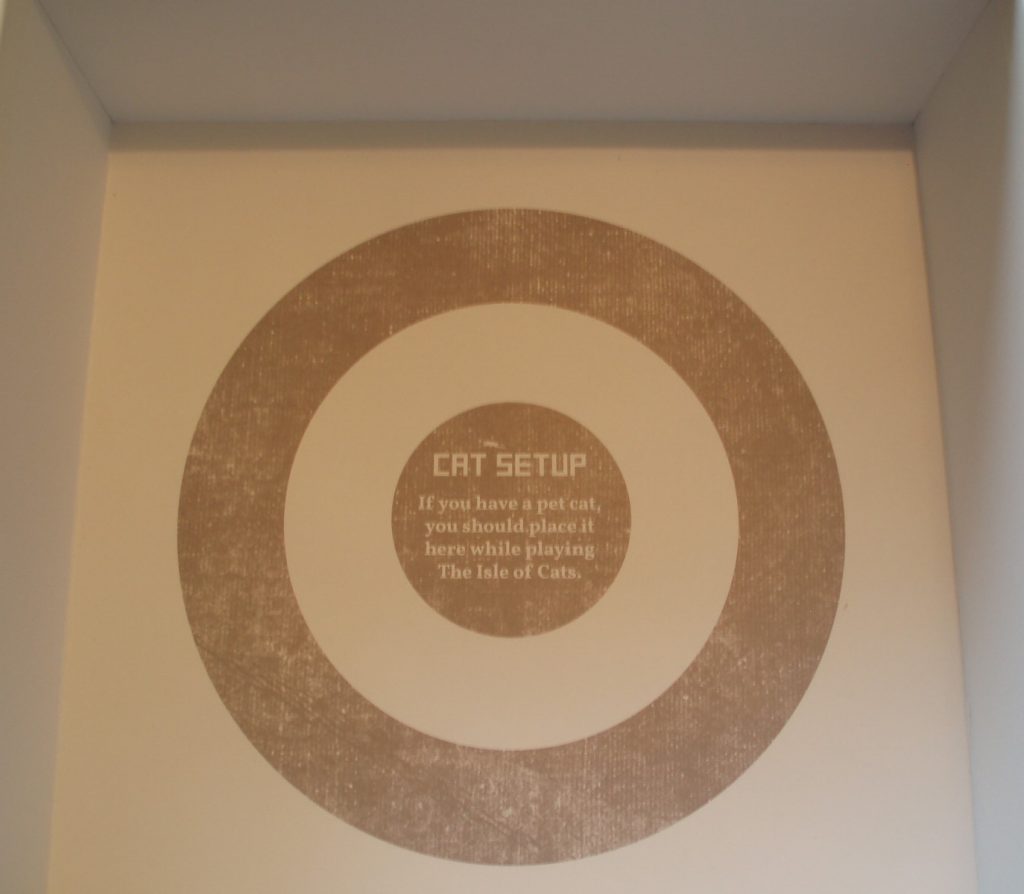
Some Choppy Seas
It’s not all smooth sailing though. The trouble with the lessons is that they’re dependent on what you’re dealt and when. There’s a lesson that rewards you richly for not placing any tiles in a specific room. Get it in the first round and you can plan for it, get it in round five and it’s probably useless. In one game I didn’t see a single lesson card until the final round, ultimately meaning I couldn’t score any lesson points. This comes down to the sheer number of cards in the deck — sometimes the deal and draft will go that way and there’s not much you can do, other than focus on other ways to score points.
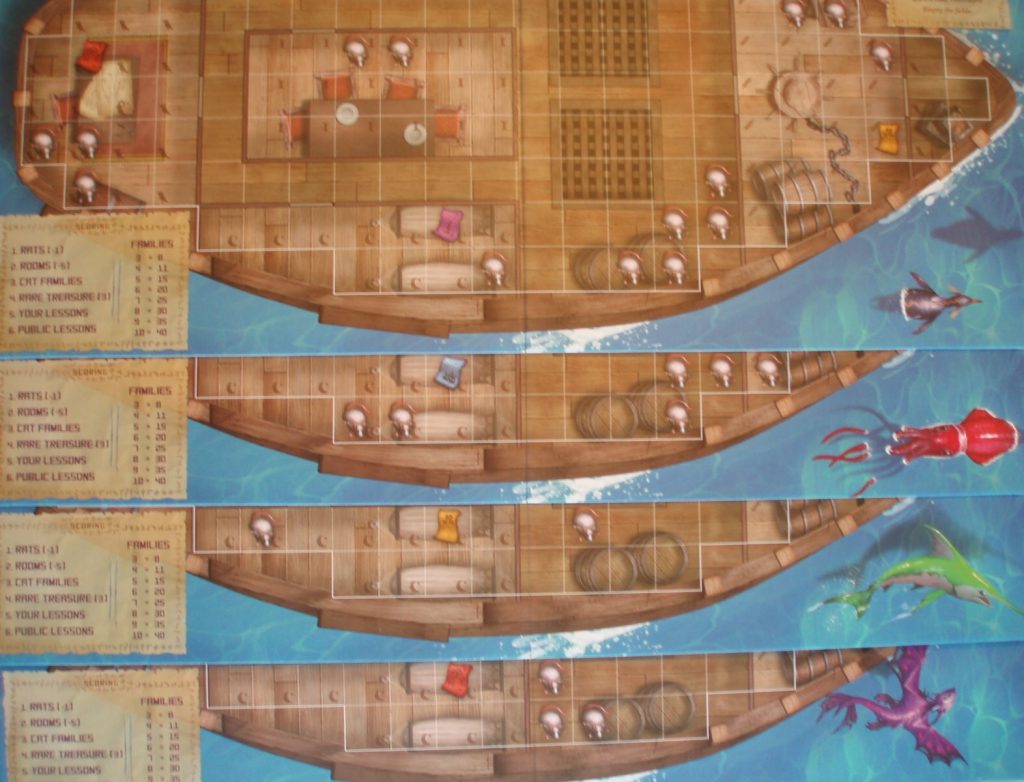
Aesthetically The Isle of Cats is gorgeous but not blemish-free. The illustration for the five fish tokens have been mistaken as three fish. The common and rare treasures are easy to distinguish when isolated but when surrounded by other tiles you rely more on the gold and brass colours, which could be clearer. Worst of all are the rooms – each square has a small icon indicating which room it is part of but they’re easily missed, leading to occasional end game groans when someone realises they’ve not filled a room they thought they had. You’ll only make that mistake once but it’s caught new players out. Less significantly, the rats look like early Pixar attempts at playing with light and shadowing and the vast tile bag is calling out for a game logo – there’s just too much beige!
During drafting, players can end up dealing with four separate stacks of cards – the draft cards, their reserved cards, private lesson cards, and any cards carried over from previous rounds. Logistically this can be awkward as your player board fills the table in front of you. Some of the cards could be clearer too – I’ve had to clear up queries about discarding your own or anyone’s lesson cards several times.

There’s also a slight thematic disconnect. The lessons, despite being explained in a story snippet, feel a bit odd when you’re meant to be frantically rescuing cats from impending doom. And why are you competing when you all have the same objective of rescuing cats? Admittedly, these are tiny quibbles but they serve to remove the game from its plot – playing The Isle of Cats doesn’t ever feel like you’re taking part in an evacuation, it feels like you’re naturalists trying to unhurriedly load as many specimens on to your boat as possible.
And yet…
Despite having written four paragraphs of flaws, none of them are a major issue and most are barely noticeable after a couple of games. Think of them as more the quirks of owning any cat – occasionally frustrating but never enough to stop you from loving it.
Family Mode
Family mode strips away all the card play and fish/basket management and focuses on tile placement. You start with a couple of lesson cards to give you a steer but otherwise you’re just taking and placing cat tiles, making family groupings and covering up rats and rooms. It’s quick, easy and as soothing as a mug of hot chocolate. We have two children under the age of three; after a day in work, playing family mode isn’t an effort yet still feels rewarding.
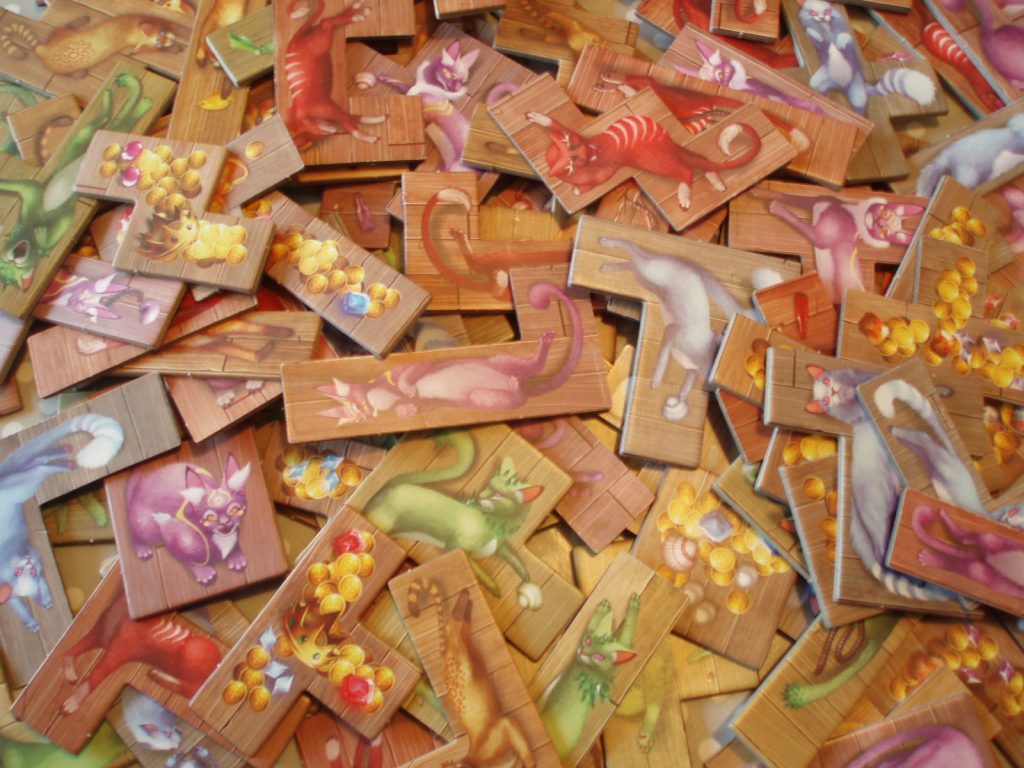
You wouldn’t buy The Isle of Cats for the family mode, but it’s a great addition for tired grownups and a good introduction to the polyomino genre for those a bit younger.
The Solo Mode
Solo mode pits you against your ‘sister’, a surprisingly devious automated opponent who takes tiles from the fields at random (irritating, mostly in a good way) and scores points based on your own player board (incredibly irritating, in an entirely good way). Your ‘sister’ has her own lessons visible from the start that she’ll be scoring against using your boat and your tiles. She’ll also score points for each colour of cat on your boat, with the amounts for each revealed over the course of the game. Combined this means that every tile you place needs consideration for both the points it gives you and the points it could give your ‘sister’. It’s a wonderful mechanic; I’d love to see it implemented in a two or more player game, perhaps with a larger, communal boat.
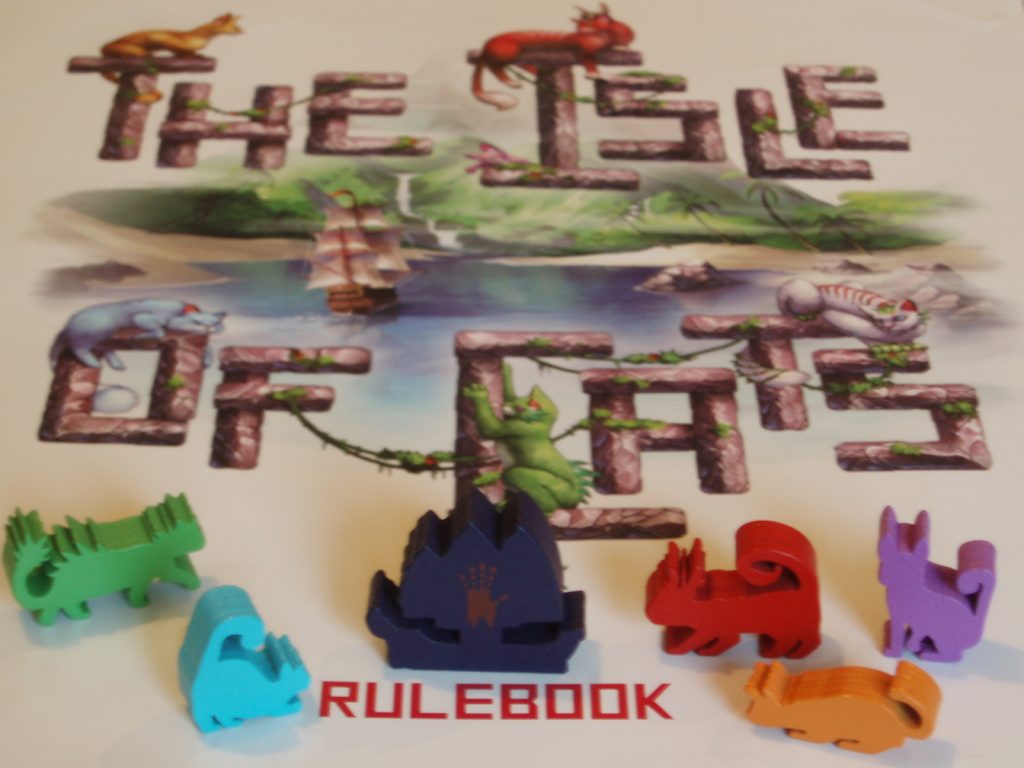
Solo mode can be a little fiddly when you first try it and your ‘sister’s’ random tile selection doesn’t always feel fair, but even if you don’t normally play solo board games it’s well worth trying for that push-pull of the scoring mechanic.
End of the Isle
In the words of Meeple Mountain’s Andrew Plassard, The Isle of Cats is a “solid game”. Despite a few minor grumbles there’s little not to enjoy: the game’s twin hearts pump interesting decisions at you during every phase, the components are easy on the eyes and you can practically taste the love that’s gone into making it.
For your sake I’ve avoided puns but let’s finish with a few:
Isle happily play this game anytime, whilst not purr-fect it’s an eye-cat-chingly boat-iful tile-tle.


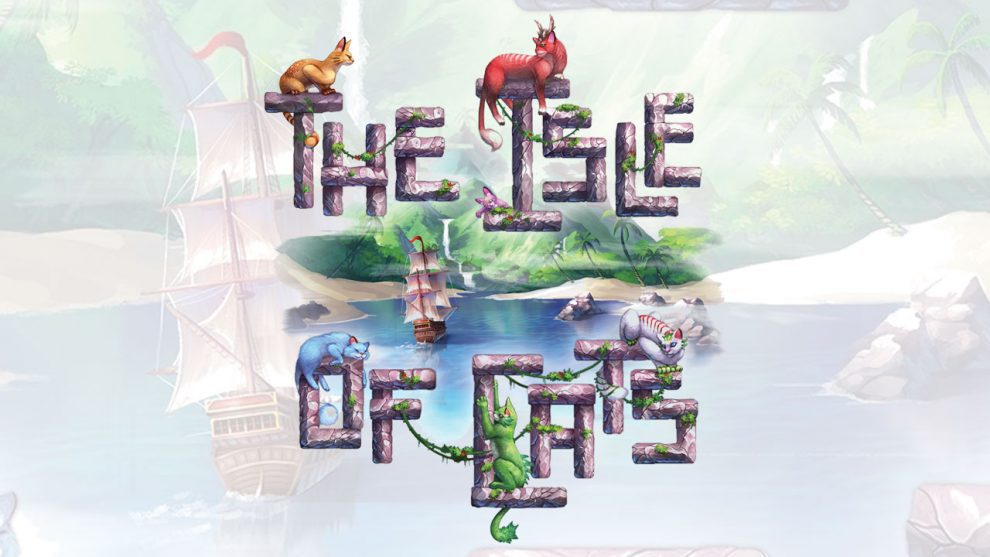




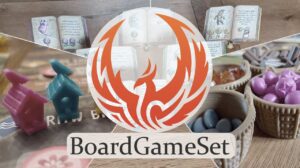




Our house at one time had five cats. I have always been more of a dog person. But both my boys *love* cats (especially my youngest) and my girlfriend is a cat person, so…
My youngest also like to play games with us. So I will have to look into getting this one as another game he might like. Thanks for the review!